Bihar’s Women Win Against Alcohol But Lose To Illicit Liquor, Drugs
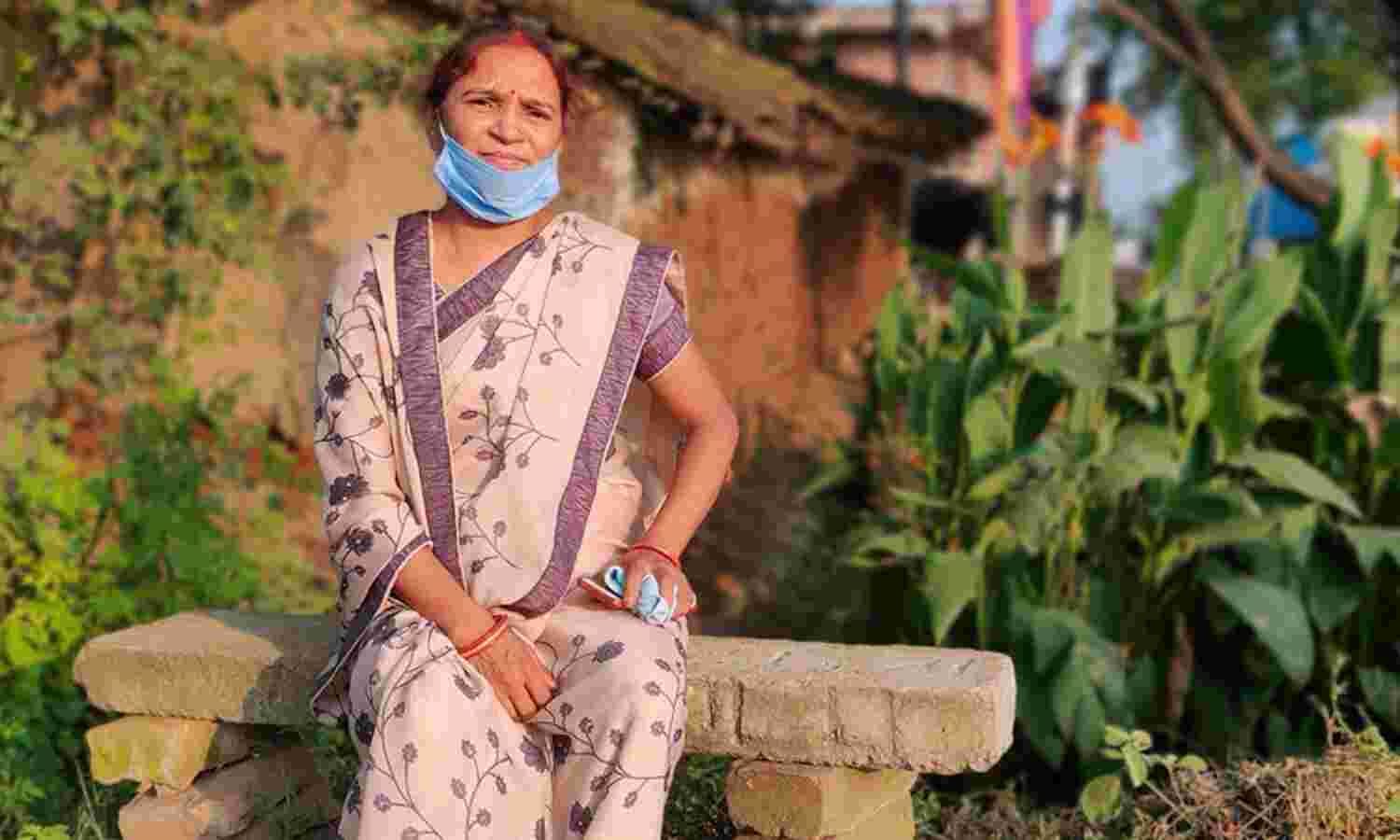
Rohtas: Her husband tried his best to dissuade her but Sakshi Devi, 30, had made up her mind. Armed with sticks, vessels and brooms, nearly 150 determined women waited outside her home in a remote village in southwestern Bihar. Sakshi Devi (name changed) reached out for the belan (rolling pin) in her kitchen and marched out of the house to join them. “We had run out of patience,” she said. “The liquor shop near the village had to go.”
The liquor shop, about a kilometre from her home and in one of the bazaars on the outskirts of Sasaram town in Rohtas district, used to bustle with male customers from several neighbouring villages, said Sakshi Devi. “It had become a ritual,” she said. “Get drunk and create nuisance at home. We could not take it anymore.”
The women, many of them Dalits, marched in rage to ambush the liquor vendor at his shop. “He pleaded with us,” Sakshi Devi recalled with a glint in her eye. “A festival was around the corner, which would have meant more sales. He promised to close the shop after the festival. But we did not budge. We went back only after padlocking the shutter.”
That was 2013. The liquor shop never reopened. Today, a quiet fodder shop occupies that space.
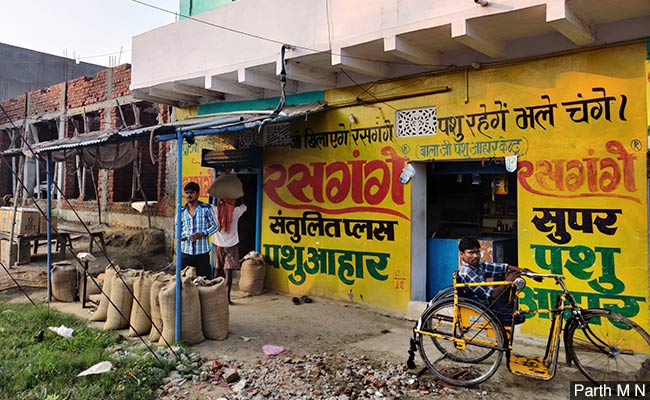
The fodder shop that replaced the liquor store in Sasaram. About 150 women from villages around it had forcefully shut it down in 2013 because men would come home drunk and beat their wives.
Over the next two years, Sakshi Devi and the women around her village participated in agitations in Sasaram under the banner of Pragatisheel Mahila Manch (progressive women’s forum) founded by Sunita Devi, 50, who had mobilised women in the shuttering of the liquor shop. “The response was overwhelming,” she said. “Not just Sasaram, such agitations took place in other parts of Bihar too. The demand was simple: complete liquor ban in Bihar.”
On April 1, 2016, chief minister Nitish Kumar declared Bihar a dry state, following in the footsteps of Gujarat, Mizoram, Nagaland and Lakshadweep. The CM enforced a five-year jail term even for first time offenders before amending the rule in 2018 to introduce a fine for first-time offenders.
Four years since the announcement, and in the run-up to the state assembly election, IndiaSpend explores in a two-part series the impact of prohibition on Bihar’s people and economy. While the National Crime Records Bureau (NCRB) data show a decline in cases of domestic abuse usually fuelled by alcohol consumption, as we explain later, prohibition has also had unintended consequences: A parallel economy of illicit liquor trade is flourishing in Bihar even as the state is losing out on revenue from alcohol sales. Bootleggers are selling alcohol at a higher price, pushing the poor towards cheap drugs and hooch.
The police crackdown on prohibition violators has also affected the marginalised sections of the society disproportionately.
In this story, the first in the series, we look at how prohibition changed the lives of the state’s women--bettering some lives but creating new problems for others.
Prohibition came at a cost
Ahead of the state elections in 2015, chief minister Nitish Kumar had promised a complete liquor ban in Bihar. In a way, he was promising to undo his own decision: In 2006, during his first of three consecutive terms as chief minister, he had liberalised the state’s liquor economy, making a policy decision to open liquor shops in every panchayat. In 2005-06, the state collected Rs 87.18 crore from Indian-made foreign liquor. In 2014-15, the collections rose to Rs 1,777 crore--a 1938% rise.
The Janata Dal (United) led by Nitish Kumar swept the 2015 state assembly polls in alliance with Lalu Prasad Yadav’s Rashtriya Janata Dal, ensuring a third consecutive term for the chief minister. Popular wisdom attributed his win to the support of women pushing for prohibition in the state.
But the change came at a cost. In 2014-15, Bihar made over Rs 3,100 crore from the sale of liquor through excise duty, according to the Economic Survey of 2016. The budgeted estimate for 2015-16 was Rs 4,000 crore, as per the survey.
Since then, the state has been losing out on all potential revenue from alcohol sales. But that does not mean the state has stopped drinking, said Sunita Devi of the women’s forum. “Much like other states with prohibition, the liquor ban has not managed to keep Bihar dry,” she said. “Alcohol is being delivered to people’s doorsteps. And with assembly elections around the corner, the enforcement of the ban is being put to test.”
Sakshi Devi was 23 when she participated in the Sasaram agitation. Her three children were aged five, four and three. “Two of them are boys,” she said. “I did not want them to grow up seeing their father creating a scene after getting drunk. Boys often emulate their fathers. He was not setting the right example for them. I did not want my boys to grow up to be abusive husbands.”
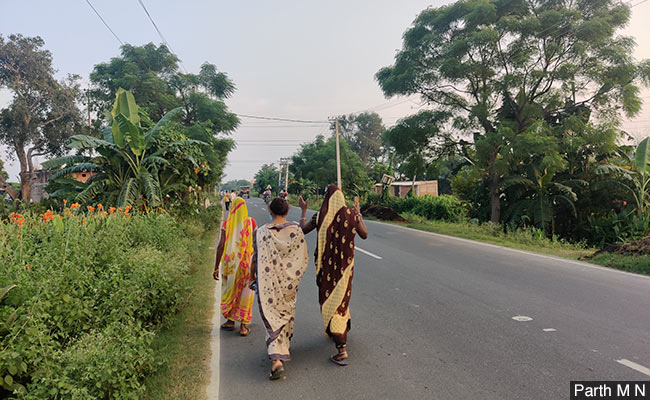
Sunita Devi walking with two women who shuttered the liquor shop in Sasaram in 2013.
Domestic violence down
For Sakshi Devi and the other women who participated in the 2013-2015 agitations, the liquor ban has yielded mixed results. “Alcohol is easily available for anyone who wants to drink,” she said. “Still there are instances of domestic violence. But it is not as brazen as it used to be.”
In the old days, women were beaten up by alcoholic husbands even for complaining about the lack of food or money at home, said Sakshi Devi. “If he earned Rs 300 as daily wages, he would splurge half of it on alcohol,” she said. “How am I supposed to run the household with the remaining money? How to buy books for kids? How to buy medicines? How to buy food grains? And when I pointed this out, it would suddenly become my fault. That was the atmosphere in which kids in Bihar grew up.”
Sandhya Kumari (name changed), 20, in the group nodded in agreement. “The situation at home is relatively calmer these days,” she said. “Earlier, I would skip a heartbeat every time my father returned home late at night. I could not concentrate on my studies. I could not read. I would only worry about my mother.”
Even though alcohol is available now, it is more expensive because it is illegal, as we said. “My father can no longer afford to drink as regularly,” said Sandhya. “We have dinner together these days. He asks about my studies. We have also been saving up more. There are odd rough days. But the frequency is not as much as it used to be.”
A World Health Organization fact sheet links intimate partner violence to alcohol consumption, “especially at harmful and hazardous levels”. It cites a multi-country study in Chile, Egypt, India and the Philippines that “identified regular alcohol consumption by the husband or partner as a risk factor for any lifetime physical intimate partner violence across all four study countries”.
In Bihar, cases of domestic violence under Section 498A of the Indian Penal Code (cruelty by the husband or his relatives) fell 37% since the liquor ban, while the crime rate--or cases per 100,000 women--fell 45%. Countrywide, during the same period, cases rose 12% and the crime rate rose 3%.
However, the data needs to be read with a few caveats, said Prashanti (she uses one name) of Gender Alliance, a non-profit organisation that works for gender equality in Bihar. “Alcohol usually works as a trigger for domestic violence,” she said. “But we have seen families where men drink and do not beat up their wives and we have also seen cases where even teetotallers are abusive husbands. More importantly, the NCRB data only includes reported cases. Most times, the woman does not lodge an official complaint against the husband because the police are non-cooperative and the patriarchal society we live in blames her.”
Economic slump, joblessness bigger worries now
Despite the drop in domestic violence, Nitish Kumar is not wholly popular among women, said Sunita Devi. “First of all, it is not a complete liquor ban [liquor is easily available],” she said. “Secondly, that is not the only job of the chief minister. Who will provide work? Who will look after the workforce? A woman has to run the household.”
Most of the women we spoke to run their homes with the wages their husbands make from labour work, which is dwindling because of agrarian distress worsened by the lockdown. “Farmers in Bihar are struggling so they cannot employ labourers at a decent wage,” said Sakshi Devi. “Therefore, those who can, migrate out of the state. The rest, like my husband, toil hours and get little in return. Little is being done to improve the quality of life of people like us. The chief minister should be responsible for employment and education as well. He cannot expect our votes on the basis of a poorly executed liquor ban.”
The state government of Bihar, though, has come up with a report card on prohibition, claiming that the policy has been a success. The average weekly expenditure on food, education and health has shown a 32%, 68% and 31% rise after the liquor ban, the report card said, further asserting that fewer women are subjected to emotional and physical violence. Of the women surveyed before the liquor ban, 79% had reported emotional violence and this is now down to 11%, said the study. In the case of physical and sexual violence, the numbers are down from 54% and 15% respectively to 5% and 4%.
However, the liquor ban has affected families in different ways, said Rupesh Kumar of Patna-based Koshish Charitable Trust. “When you implement a policy for a state as huge as Bihar, you cannot have a clear-cut outcome,” he said. “It will be complex. Some men have quit because it is now more expensive than what it was. Some have moved towards the cheap liquor that is made in villages because it is difficult to curb the urge.”
Hooch is available at Rs 50 a glass, pointed out Sukanya Devi (name changed), 55, one of the participants in the Sasaram agitation. “My life has become worse since then,” she said. “My husband works as a night watchman. He finishes his duty, downs a couple of glasses and comes home stinking. Once he is drunk, nobody can control him.”
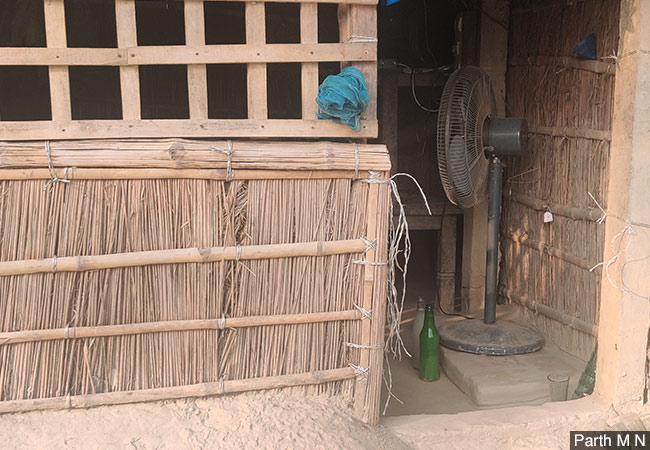
A house in a Muzaffarpur village with two bottles of hooch. The village that hardly made hooch is now producing Rs 2 lakh worth every day post liquor ban.
Hooch made at Rs 50 a litre, sold at Rs 200
The state has launched a “concerted drive” to enforce the liquor ban, said Nayyar Hasnain Khan, Inspector General (IG), Bihar Police. “It is a long-term drive and there will be ups and downs,” he said. “But the larger perception is in favour of the liquor ban. Cases of domestic violence have gone down, the roads are safer for women, and even the festivals are more peaceful.”
Khan listed some recent measures to curb the use of alcohol in Bihar. “We have created more check-posts, installed more CCTV cameras, procured canines and so on,” he said. “We even created a new position of ‘IG prohibition’. Bihar is a landlocked state. Our priority is on two fronts: One is to ensure the liquor is not smuggled in. And the other is to monitor villages where the liquor is manufactured.”
But our investigation showed that illicit brewing is rampant in the state’s interior regions.
Deep in a village in Muzaffarpur--220 km from Sasaram--Saurav Sahni, 50, (name changed) explained how hooch is made--but not before asking a basic question: “Are you from the CID [Crime Investigation Department]?”
Once he is reassured, he is candid.
“We take a 200-litre drum and bury it, leaving the top open,” Sahni said, “We mix carbide, urea, yeast, jaggery and a bit of mahua [a flower fermented to make alcohol] and let it sit for a week or so. Then we take the drum out, and keep a vessel of cold water on top of it. A plate separates the drum and the vessel.”
The next task is to make a hole near the top of the drum and heat it, Sahni added. “The solution that drips from the hole is hooch.”
The village is among the many situated along the river Gandak. “We take a boat across the river and prepare the hooch in the forests beyond it,” said Sahni. “We are currently not making it because of the elections. But we can do a video call sometime next month so you can see it live.”
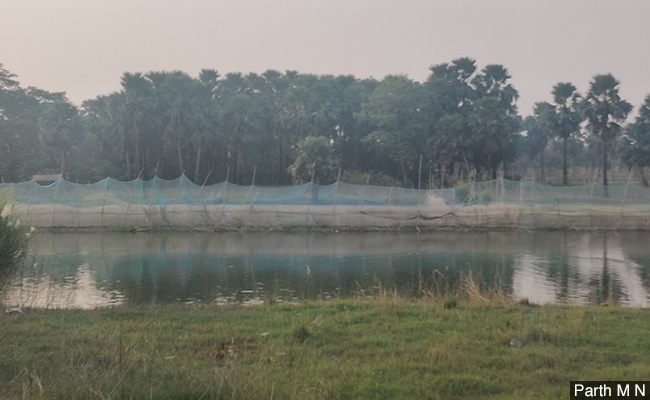
The forests beyond the river where the locals make hooch.
There are at least 50 such people in the village making 20 litres of hooch everyday, said Sahni. “This is a conservative estimate,” he said. “We spend Rs 50 to make a litre of hooch. We sell it for Rs 200.”
At this rate, a single village in Bihar can make hooch worth Rs 2 lakh everyday. “You will find people making hooch in most of the villages in Bihar. There is demand so there will be supply,” he said. “We didn’t even make 20% of this before the liquor ban.”
Hooch is far more potent than the usual whiskey, sold at a higher price in the black market now. The demand for hooch, therefore, has been on the rise, said Sushila Devi (name changed), 30, who lives in the vicinity of the alcohol shop in Sasaram that the women shut down in 2013. “Hooch is available in every village,” she said. “One glass is enough for you to be on cloud nine. My husband drinks that, and my six-year-old son watches him.”
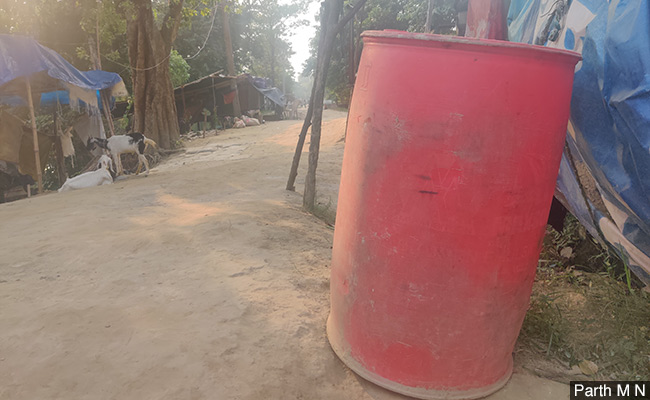
The 200-litre drum in a village of Muzaffarpur. The locals make hooch in such drums.
Sushila Devi went on to narrate an incident from a few months ago that she has not been able to forget. “One evening, my husband came to the colony drunk,” she recollected. “He was so sloshed that he collapsed before reaching the house. When my son and I walked out to fetch him, the bottle of hooch was lying beside him. My curious son ran towards him, and took a sip from the bottle. I did not know what to do. I still think about it. Did Nitish Kumar think of these fallouts when he enforced the liquor ban?”
Illicit liquor deaths
Twelve men and three women in Bihar have died drinking the village-manufactured hooch since the ban in 2016, according to the NCRB data for the years 2016, 2017, 2018 and 2019. This year, Ajay Sahni, 48, lost his cousin to the brew in January. He was 53. “He is survived by two kids and a wife,” said Sahni, a resident of Maniyari village in Muzaffarpur. “He used to work as a farm labourer in Punjab. Now his wife is doing labour work and running the household. This hooch can wreck people’s lives.”
Sahni’s brother was among the four that died in Maniyari this year drinking hooch, he said. “He was an alcoholic,” said Sahni, who is currently campaigning for a MNREGA activist contesting elections independently in Muzaffarpur. “But when you suddenly take something [substance] away, an addict can spiral out of control. They need something to satisfy their urge. My brother took hooch. Many have started doing cheap drugs.”
Drug abuse on the rise
At Disha, a de-addiction centre in Patna, Rakhi Sharma, the CEO, said she saw a sudden surge in drug addiction in the first three years following the liquor ban.
A year before the liquor ban, in 2015-16, 9,745 addicts were registered at Disha’s two main centres where addicts from across Bihar seek rehabilitation. Most belonged to families that earned less than Rs 20,000 per month, and fall into the 18-35 age group, said Sharma. Of those registered, 3,126, or 32%, had come in for alcohol, while 1,509, or 15.5%, came in for weed, charas and bhang, all cannabis extracts.
The year after the liquor ban, in 2016-17, the two centres saw 6,634 registrations. The number of alcohol addicts that year came down to 2,673, still 40% of all registered at the centre. However, the number of those addicted to weed, charas and bhang and enrolled at the centre rose to 1,921, or 29%, double the percentage the previous year.
Between 2017-18 and 2018-19, the two centres had 9,628 registrations--3,444 of them for alcohol abuse, just under 36%. But 4,427 of those registered were addicted to weed, charas and bhang, or 46%--more than three times the 14.5% recorded in the year before the liquor ban.
An inmate at the centre, who hails from a town on the outskirts of Patna, said he used to drink Imperial Blue, a brand of whiskey, before the liquor ban. “I would buy a full bottle for Rs 400 or so,” said the man in his 20s. “After the liquor ban, it started going for double the amount. So I moved to weed. I can get a packet for Rs 200 and it lasts a day as opposed to a bottle worth Rs 800 that would finish in two days. I am a farmer’s son. I used to borrow money (to drink) even at the normal rate. After the liquor ban, some friends introduced me to weed. It was a good replacement.”
Once an alcohol addict shifts to another substance, the body gets used to the replacement, said Sharma. That is what happened with the man we met. “Initially, it was also scary because the administration was strict about alcohol,” he said. “Smoking weed was safer. Later, when alcohol became easily available, I did not feel like going back to it. I kept craving for weed.”
He has been off weed for the past two and a half months and swears not to touch it again. “I have a wife and a kid,” he said. “I want to get back on my feet for them. I was lucky enough to get admitted here. But most people do not have the support system to be admitted at a de-addiction centre. The state government should have thought about that before enforcing the liquor ban.”
This is the first of a two-part series. The second part will explain bootleggers’ modus operandi and how the liquor ban has disproportionately affected the marginalised.
(Parth is a principal correspondent at IndiaSpend.)
We welcome feedback. Please write to respond@indiaspend.org. We reserve the right to edit responses for language and grammar.


